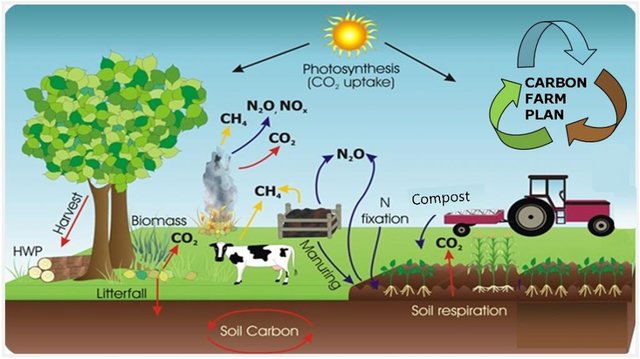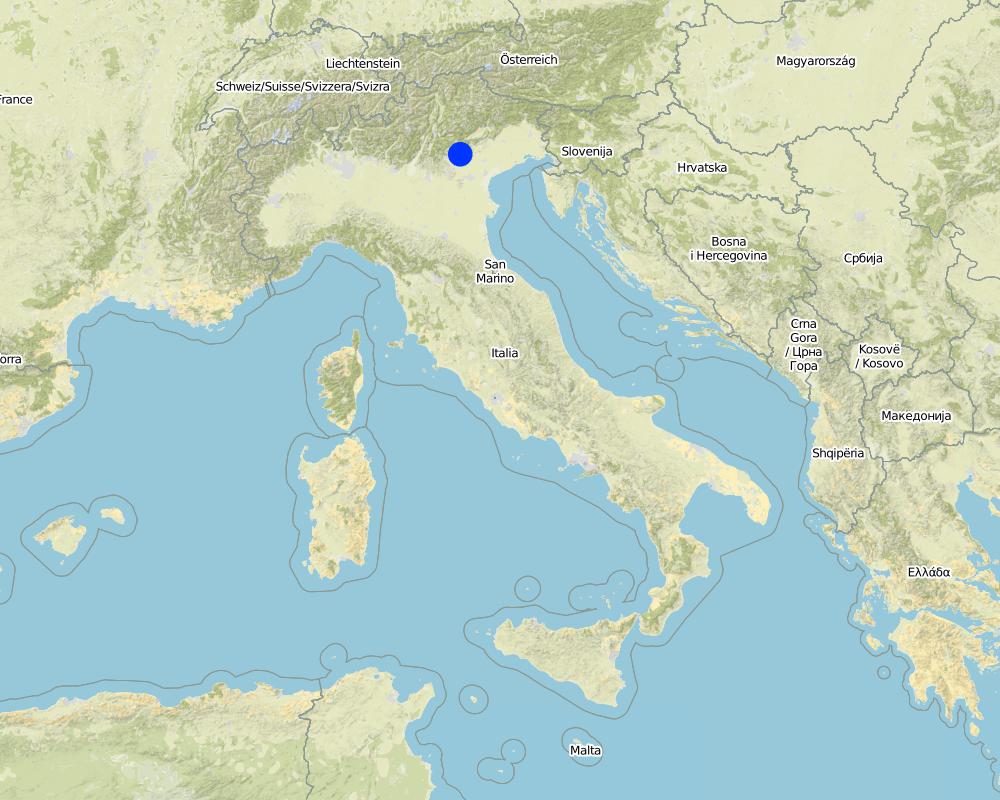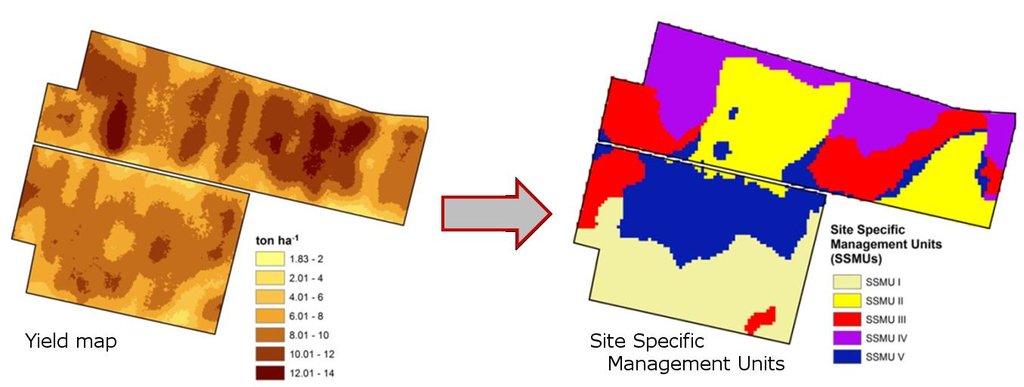Variable rate biosolids management [Italy]
- Creation:
- Update:
- Compiler: Nicola Dal Ferro
- Editor: –
- Reviewers: Valentin Zuercher, Fabian Ottiger, Alexandra Gavilano
Applicazione dose-variabile di ammendanti organici
technologies_1663 - Italy
View sections
Expand all Collapse all1. General information
1.2 Contact details of resource persons and institutions involved in the assessment and documentation of the Technology
Name of project which facilitated the documentation/ evaluation of the Technology (if relevant)
Preventing and Remediating degradation of soils in Europe through Land Care (EU-RECARE )Name of the institution(s) which facilitated the documentation/ evaluation of the Technology (if relevant)
University of Padova (UNIPD) - Italy1.3 Conditions regarding the use of data documented through WOCAT
The compiler and key resource person(s) accept the conditions regarding the use of data documented through WOCAT:
Yes
1.4 Declaration on sustainability of the described Technology
Is the Technology described here problematic with regard to land degradation, so that it cannot be declared a sustainable land management technology?
No
1.5 Reference to Questionnaire(s) on SLM Approaches (documented using WOCAT)

Carbon farming [Italy]
Managing land, water, plants and animals to meet the landscape restoration, climate change and food security.
- Compiler: Nicola Dal Ferro
2. Description of the SLM Technology
2.1 Short description of the Technology
Definition of the Technology:
Application of precision farming and variable rate application technology for spatial optimization of organic amendments use
2.2 Detailed description of the Technology
Description:
Generally, precision farming aims to increase the efficiency of cropping systems by understanding and dealing with the natural variability of the field. Here, the application of precision farming and variable rate technology approach has been proposed as a mean to optimize organic amendment inputs in croplands. Automatic application of organic inputs can be a viable way to increase farm efficiency, productivity and finally profitability.
Purpose of the Technology: Following the natural heterogeneity of the field, precision farming and variable rate technology are here applied as a SLM practice to increase the soil organic carbon (SOC), reduce losses of diffuse polllutants while increasing yield production.
Establishment / maintenance activities and inputs: Precision farming is already a feasible and useful technology in terms of automation, data process and management. In this context, site-specific application of mineral nitrogen is one of the most promising techniques to reduce the environmental impacts of nitrogen pollution. In the same way, variable-rate input of organic amendments (manure, slurry, compost etc.) can be useful for increasing the soil fertility. Spatial information of field characteristics can be overlapped with on-the-go sensors information in the field in order to provide the right dose of biosolid input.
Natural / human environment: High efficient organic application systems will provide both environmental and agronomical benefits. Nutrient management will be optimized and the loss in the groundwater will be reduced. Moreover the soil fertility will be improved by the site-specific application of organic matter, providing the best comnbination between organic inputs, nutrient requirements and reduction of nutrient losses.
2.3 Photos of the Technology
2.5 Country/ region/ locations where the Technology has been applied and which are covered by this assessment
Country:
Italy
Region/ State/ Province:
Veneto region
Comments:
This is only a potential technology that could be applied in the field. At the moment it is not applied in Veneto region.
Map
×2.7 Introduction of the Technology
Specify how the Technology was introduced:
- during experiments/ research
3. Classification of the SLM Technology
3.1 Main purpose(s) of the Technology
- improve production
- reduce, prevent, restore land degradation
- mitigate climate change and its impacts
- create beneficial economic impact
3.2 Current land use type(s) where the Technology is applied

Cropland
- Annual cropping
Number of growing seasons per year:
- 1
Specify:
Longest growing period in days: 210, Longest growing period from month to month: March to October, Second longest growing period in days: 180
Comments:
Major land use problems (compiler’s opinion): Soils in the low Venetian plain of the Veneto region generally suffer from a loss of soil organic matter (SOM) that is strongly affected by their natural texture and climatic conditions. Moreover, in the last 50 years intensive tillage practices contributed to a further SOM decrease, estimated at 0.02-0.58 t/ha/y of carbon. Finally, high intensive agriculture practices increased nonpoint source pollution and in turn caused a decline of surface and groundwater quality.
Major land use problems (land users’ perception): To date, few farmers have adopted voluntarily the continuous soil cover to reduce a decline of soil fertility and water quality, symptom of poor perception of the problem. Adoption of SLT by farmers was sustained only by means of regional subsidies.
3.4 Water supply
Water supply for the land on which the Technology is applied:
- mixed rainfed-irrigated
3.5 SLM group to which the Technology belongs
- integrated soil fertility management
- precision farming and variable rate application technology
3.6 SLM measures comprising the Technology

agronomic measures
- A2: Organic matter/ soil fertility

management measures
- M2: Change of management/ intensity level
Comments:
Specification of other management measures: Manure application management
3.7 Main types of land degradation addressed by the Technology

chemical soil deterioration
- Cn: fertility decline and reduced organic matter content (not caused by erosion)

water degradation
- Hp: decline of surface water quality
Comments:
Main causes of degradation: soil management, population pressure
3.8 Prevention, reduction, or restoration of land degradation
Specify the goal of the Technology with regard to land degradation:
- prevent land degradation
- reduce land degradation
4. Technical specifications, implementation activities, inputs, and costs
4.1 Technical drawing of the Technology
Technical specifications (related to technical drawing):
Application of manure is based on site-specific management units as defined by previously field variability.
Location: Veneto region. Italy
Technical knowledge required for field staff / advisors: high
Technical knowledge required for land users: moderate
Main technical functions: increase in organic matter, improvement of water quality, buffering / filtering water
Secondary technical functions: increase in nutrient availability (supply, recycling,…)
Change of land use practices / intensity level: Organic amendments are distributed in variable rate following the spatial and temporal variability and requirements of the field
Author:
Francesco Morari, DAFNAE - University of Padova
4.2 General information regarding the calculation of inputs and costs
other/ national currency (specify):
€
If relevant, indicate exchange rate from USD to local currency (e.g. 1 USD = 79.9 Brazilian Real): 1 USD =:
0.8
Indicate average wage cost of hired labour per day:
21.00
4.3 Establishment activities
| Activity | Timing (season) | |
|---|---|---|
| 1. | Purchase of equipment for technology application (GPS, sensors etc.) | Once |
4.4 Costs and inputs needed for establishment
| Specify input | Unit | Quantity | Costs per Unit | Total costs per input | % of costs borne by land users | |
|---|---|---|---|---|---|---|
| Labour | Purchase of equipment for technology application (GPS, sensors etc.) | |||||
| Equipment | GPS, sensors etc. | 1.0 | 10000.0 | 10000.0 | 100.0 | |
| Other | Training costs | |||||
| Total costs for establishment of the Technology | 10000.0 | |||||
| Total costs for establishment of the Technology in USD | 12500.0 | |||||
Comments:
Training for farmres is a cost that should be considered at the initial stage.
4.7 Most important factors affecting the costs
Describe the most determinate factors affecting the costs:
Machinery and technological devices
5. Natural and human environment
5.1 Climate
Annual rainfall
- < 250 mm
- 251-500 mm
- 501-750 mm
- 751-1,000 mm
- 1,001-1,500 mm
- 1,501-2,000 mm
- 2,001-3,000 mm
- 3,001-4,000 mm
- > 4,000 mm
Agro-climatic zone
- sub-humid
Thermal climate class: temperate
5.2 Topography
Slopes on average:
- flat (0-2%)
- gentle (3-5%)
- moderate (6-10%)
- rolling (11-15%)
- hilly (16-30%)
- steep (31-60%)
- very steep (>60%)
Landforms:
- plateau/plains
- ridges
- mountain slopes
- hill slopes
- footslopes
- valley floors
Altitudinal zone:
- 0-100 m a.s.l.
- 101-500 m a.s.l.
- 501-1,000 m a.s.l.
- 1,001-1,500 m a.s.l.
- 1,501-2,000 m a.s.l.
- 2,001-2,500 m a.s.l.
- 2,501-3,000 m a.s.l.
- 3,001-4,000 m a.s.l.
- > 4,000 m a.s.l.
Indicate if the Technology is specifically applied in:
- not relevant
5.3 Soils
Soil depth on average:
- very shallow (0-20 cm)
- shallow (21-50 cm)
- moderately deep (51-80 cm)
- deep (81-120 cm)
- very deep (> 120 cm)
Soil texture (topsoil):
- medium (loamy, silty)
Soil texture (> 20 cm below surface):
- medium (loamy, silty)
Topsoil organic matter:
- medium (1-3%)
If available, attach full soil description or specify the available information, e.g. soil type, soil PH/ acidity, Cation Exchange Capacity, nitrogen, salinity etc.
Soil fertility: Low
Soil drainage/infiltration: Medium
Soil water storage capacity:Medium
5.4 Water availability and quality
Ground water table:
< 5 m
Availability of surface water:
good
Water quality (untreated):
good drinking water
Is water salinity a problem?
No
Is flooding of the area occurring?
No
Comments and further specifications on water quality and quantity:
Although water salinity is not spread throughout the Veneto region, some agricultuiral aras along the coasts show problems of salt intrusion that may compromise irrigation.
5.5 Biodiversity
Species diversity:
- medium
5.6 Characteristics of land users applying the Technology
Market orientation of production system:
- commercial/ market
Off-farm income:
- less than 10% of all income
Relative level of wealth:
- average
- rich
Level of mechanization:
- mechanized/ motorized
Indicate other relevant characteristics of the land users:
Population density: 200-500 persons/km2
Annual population growth: 0.5% - 1%
Off-farm income specification: Land users that could apply such technology need substantial investments. As a result, only people with high farm income likely adopt such technology.
5.7 Average area of land used by land users applying the Technology
- < 0.5 ha
- 0.5-1 ha
- 1-2 ha
- 2-5 ha
- 5-15 ha
- 15-50 ha
- 50-100 ha
- 100-500 ha
- 500-1,000 ha
- 1,000-10,000 ha
- > 10,000 ha
5.8 Land ownership, land use rights, and water use rights
Land ownership:
- individual, not titled
- individual, titled
Land use rights:
- leased
- individual
Water use rights:
- communal (organized)
- leased
5.9 Access to services and infrastructure
health:
- poor
- moderate
- good
education:
- poor
- moderate
- good
technical assistance:
- poor
- moderate
- good
employment (e.g. off-farm):
- poor
- moderate
- good
markets:
- poor
- moderate
- good
energy:
- poor
- moderate
- good
roads and transport:
- poor
- moderate
- good
drinking water and sanitation:
- poor
- moderate
- good
financial services:
- poor
- moderate
- good
6. Impacts and concluding statements
6.1 On-site impacts the Technology has shown
Socio-economic impacts
Production
crop production
Water availability and quality
water availability for livestock
water quality for livestock
Socio-cultural impacts
Improved livelihoods and human well-being
Ecological impacts
Water cycle/ runoff
water quality
Soil
nutrient cycling/ recharge
soil organic matter/ below ground C
Climate and disaster risk reduction
emission of carbon and greenhouse gases
6.2 Off-site impacts the Technology has shown
groundwater/ river pollution
6.3 Exposure and sensitivity of the Technology to gradual climate change and climate-related extremes/ disasters (as perceived by land users)
Gradual climate change
Gradual climate change
| Season | increase or decrease | How does the Technology cope with it? | |
|---|---|---|---|
| annual temperature | increase | not known |
Climate-related extremes (disasters)
Meteorological disasters
| How does the Technology cope with it? | |
|---|---|
| local rainstorm | not known |
Other climate-related consequences
Other climate-related consequences
| How does the Technology cope with it? | |
|---|---|
| reduced growing period | not known |
6.4 Cost-benefit analysis
How do the benefits compare with the establishment costs (from land users’ perspective)?
Short-term returns:
slightly negative
Long-term returns:
positive
How do the benefits compare with the maintenance/ recurrent costs (from land users' perspective)?
Short-term returns:
slightly negative
Long-term returns:
positive
6.5 Adoption of the Technology
- single cases/ experimental
Comments:
The technology is not yet applied, but only proposed because it is still in research/experimental phase. However stakeholders showed interest in the technology for a future adoption of the technology.
6.7 Strengths/ advantages/ opportunities of the Technology
| Strengths/ advantages/ opportunities in the compiler’s or other key resource person’s view |
|---|
| Soil spatial variability is taken into account |
| Reduces diffuse water pollution |
| Optimizes soil organic matter needs |
6.8 Weaknesses/ disadvantages/ risks of the Technology and ways of overcoming them
| Weaknesses/ disadvantages/ risks in the compiler’s or other key resource person’s view | How can they be overcome? |
|---|---|
| High intial costs | training |
| High expertise for technology use |
7. References and links
7.1 Methods/ sources of information
- field visits, field surveys
- interviews with land users
When were the data compiled (in the field)?
23/04/2015
7.2 References to available publications
Title, author, year, ISBN:
Moshia et al., 2015. Precision Manure Management on Site-specific Management Zones: Nitrogen Mineralization. Journal of Plant Nutrition 39 (1).
Available from where? Costs?
http://dx.doi.org/10.1080/01904167.2015.1009547
Links and modules
Expand all Collapse allLinks

Carbon farming [Italy]
Managing land, water, plants and animals to meet the landscape restoration, climate change and food security.
- Compiler: Nicola Dal Ferro
Modules
No modules



